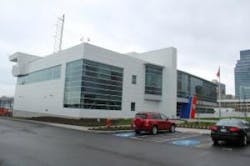2013 Design/Build Awards: Comfort on the North Coast
The 9th District U.S. Coast Guard facility at Cleveland Moorings in downtown Cleveland, OH, is a new 25,000-sq.ft. facility for operations, administration and crew-berthing. The facility’s dedicated staff oversees activities that span the five Great Lakes, the Saint Lawrence Seaway, and parts of the surrounding states, including 6,700 miles of shoreline and 1,500 miles of the international border with Canada.
KW Lang Mechanical of Solon, OH explored the comfort cooling options, and decided to use a VRF system from LG Electronics, due to its energy efficiency and cost-effectiveness. The building’s overall energy reduction was 40.6%, with a cost savings of 38.6% over other systems.
Key to the facility’s energy savings was the decision to combine Greenheck dedicated outside-air units with the LG variable-refrigerant system. Sources report this decision allowed for 40 separate thermostatically controlled zones. The outside-air units provide a ventilation rate 30% higher than current ASHRAE 62.1 standards. Assisting in efficiency, the building’s mechanical and electrical systems are monitored and controlled by a direct digital control building automation system.
One of the major challenges with this building was the different load profiles. At the same time, some areas of the building require heat, and others require cooling. The ability of VRF technology to heat or cool specific areas of a building simultaneously in an energy-efficient manner made it an ideal fit for climate control on this project.
However, what is truly unique about this project is the indoor mechanical room. VRF system condensing units are normally placed outside on the ground or on the roof, but the units in the Coast Guard building have been installed inside, within a mechanical room on the building’s third-floor mezzanine. The reason is that in the summer, air will exhaust through the condensing units to the outside, but during the winter, the heated air is recirculated within that inner mechanical room, supplemented by Modine 93%-efficiency unit heaters, allowing the room to maintain a year-round temperature in the room of no lower than 37F, thus providing the VRF system with peak efficiency. The project is LEED Gold certified

